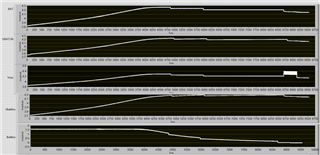When impedance compensation is disabled we mostly see the current/voltage curves captured in Figure 13 in that the battery charges at the fast-charging-current setting (1.536A) until the voltage at the BAT pin reaches the set voltage (4.208V). However, when impedance compensation is enabled (changing REG06 from 03 to FF) we see the following unexpected behavior which does not seem to be described in the datasheet or in this forum:
- There seems to be some sort of algorithm titrating current as follows (and shown in the plots below):
-
- Constant-current mode ~1.5A until the set voltage (4.208V) is reached (as measured at BAT), at which point the current starts to slowly drop.
- The current suddenly drops when BAT reaches Vset +IRCOMP/2 (=4.208 + I*70mOhm =4.238V with I=~1.1A), suddenly dropping BAT by ~25mV (down to 4.213V).
- The current slowly drops until BAT reaches Vset +IRCOMP/2 (=4.208 + I*70mOhm), which occurred at 4.223V with I=~563mA) --- at which point the current suddenly drops until BAT drops by ~25mV (down to 4.195V).
- The current slowly drops until BAT reaches Vset (=4.208), which occurred at 4.204V --- at which point the current suddenly drops until BAT drops by ~25mV (down to 4.179V).
- Charging then stops when the termination threshold is reached (128mA).
-
- We have also seen the output current dropping to ~2-to-50mA (far below the threshold current) without stopping charging. A few times we have captured the Status register indicating DPM (most likely due to voltage limiting). The input voltage oscillates between ~5V (nominal DC input) and 4.20V (the min voltage setting via REG00=27). The output voltage (VSYS) oscillates between the battery voltage and the higher system voltage (seemingly due to the battery charger opening and closing the internal FET). These oscillations seem to occur between 1ms and 3ms intervals.
Even though this behavior seems to be indicative of DPM (via voltage limiting), there does not seem to be any reason for such limiting as our AC-DC adaptor is no where near its rated current output of 2.4A, and we haven't seen this DPM (or algorithmic behavior) with impedance compensation deactivated. Is there anything in the inner workings of the battery charger that could account for these 1-to-3ms intervals?
Has anyone else seen similar behavior and can offer any potential solutions? Is the impedance compensation functionality known to be quirky?

Thank you,
Paul


